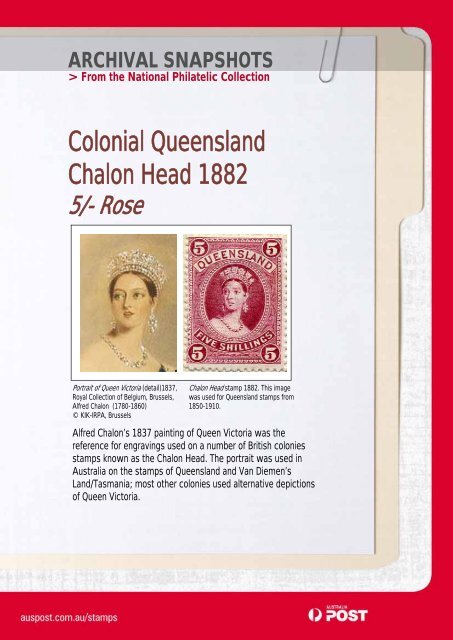Colonial Queensland Chalon Head 1882 - Australia Post
Colonial Queensland Chalon Head 1882 - Australia Post
Colonial Queensland Chalon Head 1882 - Australia Post
Create successful ePaper yourself
Turn your PDF publications into a flip-book with our unique Google optimized e-Paper software.
ARCHIVAL SNAPSHOTS<br />
> From the National Philatelic Collection<br />
<strong>Colonial</strong> <strong>Queensland</strong><br />
<strong>Chalon</strong> <strong>Head</strong> <strong>1882</strong><br />
5/- Rose<br />
Portrait of Queen Victoria (detail)1837,<br />
Royal Collection of Belgium, Brussels,<br />
Alfred <strong>Chalon</strong> (1780-1860)<br />
© KIK-IRPA, Brussels<br />
<strong>Chalon</strong> <strong>Head</strong> stamp <strong>1882</strong>. This image<br />
was used for <strong>Queensland</strong> stamps from<br />
1850-1910.<br />
Alfred <strong>Chalon</strong>’s 1837 painting of Queen Victoria was the<br />
reference for engravings used on a number of British colonies<br />
stamps known as the <strong>Chalon</strong> <strong>Head</strong>. The portrait was used in<br />
<strong>Australia</strong> on the stamps of <strong>Queensland</strong> and Van Diemen’s<br />
Land/Tasmania; most other colonies used alternative depictions<br />
of Queen Victoria.
ARCHIVAL SNAPSHOTS<br />
> From the National Philatelic Collection<br />
Portrait of Queen Victoria, 1837, Alfred <strong>Chalon</strong>, Royal Collection of Belgium, © KIK-IRPA, Brussels<br />
Original Portrait<br />
The portrait head of Queen Victoria came from a painting by Alfred Edward<br />
<strong>Chalon</strong>, inspired by the first public appearance of Victoria as Queen on the<br />
occasion of her speech at the House of Lords where she opened the<br />
Parliament of the United Kingdom in July 1837. <strong>Chalon</strong>'s work was<br />
intended as a gift from Victoria to her mother. In the portrait she is<br />
wearing the George IV State Diadem, created in 1820, and the State<br />
Robes, a dress and a long royal mantle. Her body is half-turned to the right<br />
side, on top of a flight of stairs. While her head is turned to the right, her<br />
left hand holds the plinth of a column on which there is a sculpted lion. At<br />
that time, this portrait was also known as the "Coronation portrait" and an<br />
engraving by Samuel Cousins was distributed to the public on 28 June,<br />
1838.
ARCHIVAL SNAPSHOTS<br />
> From the National Philatelic Collection<br />
The Artist<br />
Alfred <strong>Chalon</strong> 1780-1860 RA<br />
<strong>Chalon</strong> was born in Geneva, Switzerland but left as a result of troubles<br />
arising from the French Revolution. The family eventually settled in London<br />
where Alfred and his brother John both became students at the Royal<br />
Academy. He was made a full Academician in 1816 and became known<br />
for painting miniatures on ivory. He also painted small portraits in<br />
watercolour on paper, often about 15 inches high. He was a witty<br />
caricaturist, and also painted genre and history subjects. His elegant<br />
miniatures and watercolour portraits were hugely fashionable. He was<br />
especially popular in court circles and was appointed painter in<br />
watercolour to Queen Victoria. He famously said when asked by the Queen<br />
whether he was worried by competition from the new invention of<br />
photography, “Ah non, Madame, photography can’t flatter!”. The portrait<br />
head of Queen Victoria came from a painting by Alfred Edward <strong>Chalon</strong>,<br />
inspired by the first public appearance of Victoria as Queen on the<br />
occasion of her speech at the House of Lords where she opened the<br />
Parliament of the United Kingdom in July 1837.<br />
Tasmania (Van Diemen’s Land) <strong>Chalon</strong> <strong>Head</strong> – Imperforate<br />
1d red, 2s green, 4d blue, 6d purple, 1/- orange
ARCHIVAL SNAPSHOTS<br />
> From the National Philatelic Collection<br />
Queen Victoria, portraiture and <strong>Australia</strong>n stamps<br />
Young Queen<br />
Pencil sketch for New<br />
South Wales ‘Diadems’<br />
c1851<br />
No sovereign had her image<br />
reproduced more often than Queen<br />
Victoria. Depictions appeared on<br />
medals, shaving cups, gongs, napkin<br />
rings, cufflinks, inkwells, paperclips,<br />
pipes, tea towels, pot lids, coins,<br />
postage stamps and also on<br />
Canadian canoes and <strong>Australia</strong>n<br />
.<br />
prison ships.<br />
Victoria enjoyed many portraits<br />
made of her throughout her lifetime,<br />
portraits she often commissioned as<br />
family gifts or records for the public.<br />
Over the decades her image altered<br />
from innocent princess and young<br />
Queen to wife, mother, widowed<br />
matriarch and moral guardian of the<br />
country.<br />
‘Diadems’ 1854-1860<br />
New south Wales
ARCHIVAL SNAPSHOTS<br />
> From the National Philatelic Collection<br />
Queen Victoria 1838<br />
Alfred <strong>Chalon</strong> (1780-1860) ©<br />
National Portrait Gallery, Scotland<br />
Queen Victoria 1843<br />
Franz Xavier Winterhalter<br />
(1805-1873) German<br />
painter and lithographer<br />
The Royal Collection ©<br />
2010, Her Majesty Queen<br />
Elizabeth II<br />
Self-portrait, (detail)<br />
Queen Victoria aged 25<br />
1844 The Royal Collection<br />
© 2010, Her Majesty<br />
Queen Elizabeth II<br />
Domestic<br />
This watercolour by <strong>Chalon</strong> was<br />
the very first portrait the young<br />
queen sat for after her accession to<br />
the throne. She is dressed in the<br />
robes she wore when Parliament<br />
was dissolved after her uncle’s<br />
death. Her hat is casually discarded<br />
on the floor, she wears a<br />
decorative apron which gives a<br />
more domestic focus to this and<br />
other portraits produced during the<br />
middle period of her reign.<br />
Feminine<br />
Queen Victoria commissioned Franz<br />
Winterhalter to paint this romantic,<br />
and quite intimate portrait of her as<br />
a gift to her husband Prince Albert<br />
of Saxe-Coburg Gotha on his 24 th<br />
birthday. The oval frame, soft face,<br />
loose hair and bare shoulders show<br />
a more feminine figure.<br />
Sovereign<br />
Victoria’s sketch self-portrait<br />
shows a reflected gaze which is<br />
without hesitation as to its owner’s<br />
character as well as her sense of<br />
sovereign purpose
ARCHIVAL SNAPSHOTS<br />
> From the National Philatelic Collection<br />
Queen Enthroned<br />
State portrait of Queen Victoria<br />
Sir George Hayter, oil on canvas,<br />
(1838) National Portrait Gallery.<br />
Photographic reproduction in<br />
National Philatelic Collection<br />
(Detail from portrait) ©<br />
National Portrait Gallery<br />
London<br />
Queen on Throne stamp<br />
(reprint) (Coronation<br />
Throne) 1852-54<br />
Engraving after Sir<br />
George Hayter’s State<br />
Portrait<br />
Sir George Hayter was the Queen’s<br />
“Portrait and Historical Painter” and<br />
in 1841 was made “Principal<br />
Painter in Ordinary to the Queen”.<br />
He painted several royal<br />
ceremonies including Queen<br />
Victoria’s coronation of 1837 and<br />
marriage of 1840 and also the<br />
christening of the Prince of Wales<br />
of 1843. He also painted several<br />
royal portraits including his most<br />
well known work, the State Portrait<br />
of the new Queen Victoria. Several<br />
versions of this portrait were done,<br />
to be sent as diplomatic gifts.<br />
Hayter's active period at court was<br />
short-lived because Prince Albert<br />
preferred German painters. By the<br />
mid-1840s Hayter’s portrait style<br />
was considered old-fashioned. He<br />
adjusted his type of history painting<br />
to suit the more literal taste of the<br />
early Victorian era. Although a very<br />
simplified interpretation, the fulllength<br />
Queen on Throne stamp<br />
captures the early Victorian gothic<br />
style with the pointed design of the<br />
Coronation Throne and in the<br />
decorative elements and<br />
background borders of the<br />
engraved stamp.
ARCHIVAL SNAPSHOTS<br />
> From the National Philatelic Collection<br />
Widowed matriarch<br />
Queen Victoria ,<br />
Photographer, Alexander<br />
Bassano 1885<br />
National Portrait Gallery,<br />
London<br />
Commemorative<br />
Diamond Jubilee<br />
Canada 5c<br />
Queen Victoria,<br />
Diamond Jubilee 1897<br />
Photography W & D<br />
Downey ©<br />
National Portrait Gallery,<br />
London<br />
Definitive stamps<br />
1897-1910 2d, 21/2d<br />
New South Wales<br />
Victoria’s interest in portraiture reflected the Victorian interest in<br />
realism influenced by the development of photography which was of<br />
great interest to the Queen. She kept photographic albums, attended<br />
photographic exhibitions and fervently supplied her portraitists with<br />
photographs of their subject for reference. Images of Victoria that<br />
appeared on stamps were based on engravings or lithographs derived<br />
from either photography, paintings or watercolours.
ARCHIVAL SNAPSHOTS<br />
> From the National Philatelic Collection<br />
Queen Victoria as guardian and embodiment of the<br />
Empire<br />
Portrait of Queen Victoria,<br />
(detail) Photographer<br />
Alexander Bassano ©<br />
National Portrait Gallery,<br />
London<br />
Patriotic Fund,<br />
<strong>Queensland</strong><br />
1900<br />
Patriotic Fund,<br />
<strong>Queensland</strong><br />
1900<br />
There had been general criticism of portraits of Queen Victoria as lacking in<br />
vitality and being unsmiling but it was also known that Queen Victoria used<br />
portraiture to hide her smile and emphasise her serious image as a sovereign.<br />
After Queen Victoria’s husband Prince Albert passed away in 1861, the Queen<br />
went into a very long period of seclusion and withdrawal from public life which<br />
lasted almost 10 years (1861-1871). It said that she needed to reassert her<br />
claim to the monarchy and did so through portraits representing her as a<br />
powerful monarch hardened by personal grief and widowhood. Portraits of<br />
the 1870s show her as a resolute guardian and embodiment of English power.<br />
This later image of Victoria persisted until her death in 1901.<br />
Further reading:<br />
Portraits of the Queen Ira B Nadel, Victorian Poetry, Vol.25, No. 3/4 , Centennial of Queen Victoria’s golden<br />
Jubilee (Autumn-Winter, 1987), pp.169-191, West Virginia University Press













